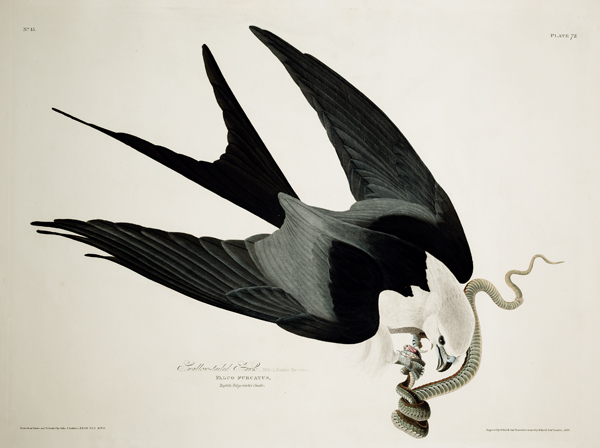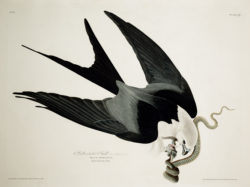John James Audubon
Artist John James Audubon completed some of his most notable paintings for "The Birds of America" while in Louisiana.

Courtesy of Louisiana State University Libraries, Special Collections.
Color reproduction of a watercolor engraving entitled "Swallow-Tailed Hawk" by John James Audubon.
Naturalist and painter John James Audubon is known principally for his pictorial survey The Birds of America, which was published on a serial basis between 1827 and 1838. Although Audubon roamed much of the eastern United States in pursuit of his art, he did more pictures for The Birds of America in Louisiana than in any other single place. Audubon began working on at least 167 of the 435 images in The Birds of America while living in Louisiana. His work in Louisiana was distinguished not only by its quantity, but also its quality. His birding in Louisiana inspired some of his most memorable paintings, including the wild turkey cock (which was the first plate in The Birds of America) and the swallow-tailed hawk.
Born April 26, 1785, Audubon often identified himself as a native of Louisiana, claiming to have been born on a plantation near Mandeville. The story was fiction, however, an apparent attempt to mask his illegitimate birth in what is now Haiti. The son of Lieutenant Jean Audubon, a French naval officer, and his mistress Jeanne Rabin, Audubon lost his mother at an early age. After spending much of his childhood at an ancestral home in France, Audubon immigrated to the United States in 1803 to manage his father’s plantation in Pennsylvania. He eventually married and moved to Kentucky, where he became a successful merchant.
After losing his fortune during the Panic of 1819, Audubon decided to devote full attention to his art, undertaking The Birds of America. Audubon arrived in New Orleans in early 1821, hoping to find portrait commissions to help finance his project. In the spring of 1821, He met Lucretia Pirrie, mistress of Oakley Plantation in St. Francisville, who offered him a part-time job, plus room and board, as tutor to her fifteen-year-old daughter. Audubon was allowed to spend the rest of his time combing Oakley’s woodlands for bird specimens, and the area’s abundance of bird life inspired one of Audubon’s most successful artistic periods. Audubon spent only four months at Oakley, but the experience provided a window into birding wonders around southern Louisiana. He returned periodically to the region around Oakley, working on at least eighty of the images in The Birds of America during the twenty-three months he spent in the area.
Between 1821 and 1837, Audubon spent much of his time in Louisiana. “The state of Louisiana has always been my favorite portion of the Union, although Kentucky and some other states have divided my affections,” Audubon once wrote. His wife, Lucy, and his two sons, Victor and John Woodhouse Audubon, eventually moved from Kentucky to Louisiana, where Lucy supported the family by working as a teacher at Beech Woods Plantation in West Feliciana Parish. In New Orleans, Audubon refined techniques to render the rich textures and layering of color that distinguished his paintings. In addition to his visual art, Audubon was an accomplished nature writer, and much of his best writing, most notably his vivid journal entries, originated in Louisiana.
Consisting of 435 life-sized, hand-colored prints made from engraved plates, The Birds of America was first published in an eighty-seven part series between 1827 and 1838. Its critical success made Audubon famous almost immediately. Audubon died on January 27, 1851 in New York City. In New Orleans, Audubon Park, Audubon Zoo, and the Audubon Aquarium of the Americas are named after him. Today, the house and remaining grounds of Oakley Plantation in St. Francisville are open to the public as the Audubon State Historic Site. “Audubon: A Vision,” a poem cycle by Robert Penn Warren, was inspired by Audubon’s Louisiana period.
